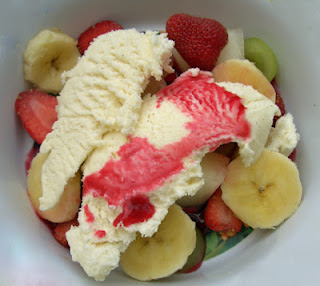We are all familiar with the story of Sleeping Beauty. Like so many fairy tales, there is a moral to it but it is parents who can learn from it. So terrified of the curse put upon their daughter, the king and queen burnt all the spinning wheels in the kingdom in order to prevent Sleeping Beauty ever coming into contact with one. Surely, if they had left the textile industry intact and merely explained to their daughter about the curse she would have known to have steered well clear of the spinning wheel in the tower.
I know what you're thinking, what's this got to do with anything jam related? Well, as you'll know I have two young apprentices (my 8 and 10 year old daughters), who when in the right mood, can be rather helpful in the kitchen. But for many people kids and kitchens don't mix. It is certainly true that most accidents happen in the home and of all the rooms in the home, the kitchen is the most dangerous. It is little wonder then that people choose to keep their kids well clear. However, it is my belief that children can and should be part of the kitchen, just suitably educated on the dangers to help them stay safe.
 |
| 6 and 4 years old, already helping in the kitchen |
The main dangers in the kitchen are of course the oven/hob and knives. When my children were babies and toddlers I had a stair gate across the middle of kitchen so that they could not get anywhere near these dangers. They were simply too young to understand the dangers. But as they have grown up I have allowed them into the kitchen, explaining along the way what the dangers are and why. The stair gate is long gone and they have been using the hob and knives under supervision for several years now. In my opinion, the biggest danger in the kitchen is ignorance. Showing them how to do things safely is the way forward.
When my eldest daughter was in Year 2 (6-7 year olds), I ran the
Let's Get Cooking club at her school. Each week I had a group of 6 children to teach cooking skills to. Using the hob and knives were an important part of this club. It was heartening to be allowed in a school situation to teach these useful skills and for health and safety to not be so over the top as to block this.
When my daughter entered Year 3 she moved to the next school up and spent the first 6 weeks of the autumn term learning how to make a sandwich in her DT lessons. How exasperating! Sandwiches?! This is a child who can make a Victoria sandwich cake! The same child who made Piccalilli from scratch as a Christmas gift to her teacher the same year.
 |
| Making Piccalilli aged 8 |
I know, teaching a child one to one at home how to use a knife safely is something far removed from trying to do it with a class of 30. But, hey, I used to be a secondary Science teacher and used to have classes of 30 hormonal teenagers using Bunsen burners, chemicals and scalpels! Seven years of teaching and no one ever ended up in hospital. We really do need to have faith in our children and allow them to learn how to do things safely rather than just not allowing them to do it for fear of injury.
So, given that knife skills is not something children are likely to learn in school, take the opportunity to teach them to your children if you can. I'm not talking about chefy knife skills - you know, that super quick chopping thing they do - just basic correct handling of a knife and safe chopping.
Here is my list of key points for children for being safe with knives.
1. Never use a knife unless there is an adult with you.
2. Choose the correct knife for the job - not too big or too small, and not too sharp or too blunt for the task.
3. When carrying a knife always hold it down by your side, pointing towards the floor.
4. Always use a chopping board to protect both the work surface and the knife blade.
5. Make sure your work area is tidy so that you can move freely without knocking things over.
6. Make sure your hands are clean and dry so that you have a firm grip.
7. Use the correct grip (claw or bridge) on the food to keep your fingers away from the knife blade and re-position them as necessary as you work.
 |
| Bridge |
 |
| Claw |
8. Watch what you are doing at all times, concentrate and take your time.
9. Never put your knife into a bowl of washing up. Instead, keep hold of it and carefully wipe the blade clean with a brush or sponge.
With a little practice you too could have a useful, trustworthy kitchen helper and someone set up with some really important life-skills.



















































